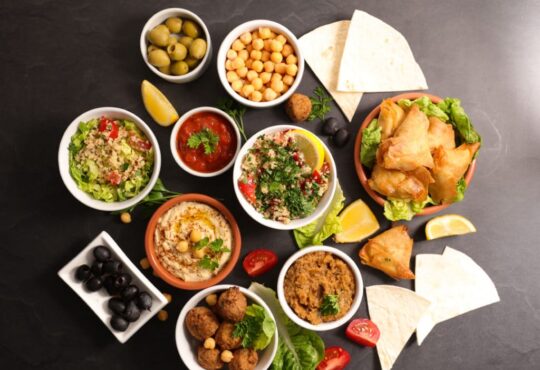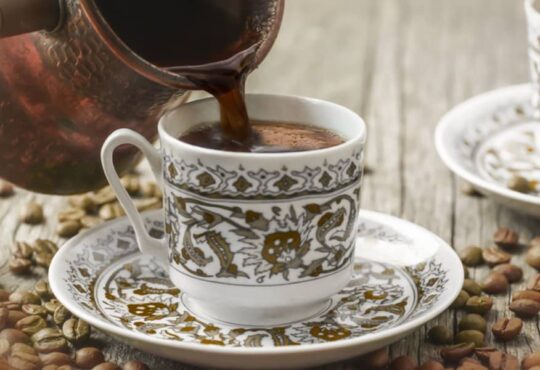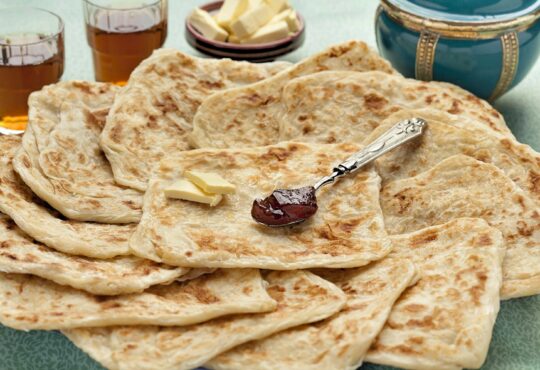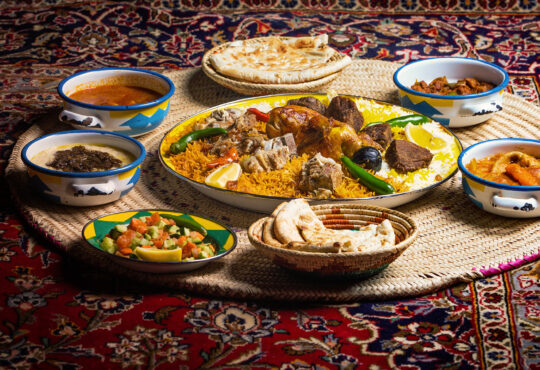1.1K
Tunisian food is unique in its kind. Tunisians often say that their traditional dishes are delicious, and they’re right. If you’re like me and you love trying new foods, then Tunisian food should be on your bucket list.
Traditional Tunisian cuisine and food includes a vast variety of dishes with different flavors. It is influenced by the three main regions of Tunisia, where there are spicy foods commonly found in the south, very sweet from the center, and spicy foods from the Tunisian Sahara.
So what are the best foods to try when visiting Tunisia? Check out our list below!
Disclaimer: Please keep in mind that we may receive a commission when you click on our links and make a purchase. This, however, has no bearing on our reviews.
30 Must Taste Tunisian Foods
Tunisian Couscous
Tunisian Couscous is the most popular traditional dish served in Tunisia. It’s regarded as the national dish after all!
This delightful dish is prepared with semolina grains, vegetables and vegetable broth, raisins, dried fruit, almonds, saffron, and meat. Various meats can be used in the dish like lamb, fish, and chicken.
Couscous is known to be a part of North African cuisine, distinctively in the Moroccan food culture.
Have you heard about the Moroccan Tajine dish? If yes, you must not confuse it with the Tunisian Tajine because it’s a far departure from it. Tajine in Tunisia is really more of an appetizer and not the main dish.
The Tunisian Tajine is made of ground beef, eggs, vegetables (potatoes and onions), spices and cheese. This Tunisian Fritatta-looking dish can be a great side dish or snack anytime throughout the day.
Tunisian Shakshuka (Ojja)
Known also as Tunisian Shakshuka, Ojja is a Tunisian dish that is made of spicy tomato sauce with eggs on top.
(Ojja) Shakshuka is a staple dish in Tunisia. It’s traditionally flavored with garlic, olive oil, and spices. However, other versions are cooked in different regions of the country like the Shrimp Ojja or Merguez (Tunisian sausage) Ojja.
Usually served in a Tajine pot or an iron skillet, Ojja is an easy and light meal, which makes it perfect for either breakfast, lunch, or dinner!
Brik
Tunisian Brik is a Tunisian food consisting of eggs, tuna, and bread. Some consider Brik to be the national dish of Tunisia.
Found in both Algeria and Libya, the Tunisian version of Brik is made by folding a pastry dough over an egg and frying it. You can also find Brik with Tuna, chicken, and cheese fillings.
Tunisian Brik is commonly served with a side of Harissa (a hot pepper paste sauce). If you are looking for quick street food in Tunisia, It’s hands down the Tunisian Brik.
Tunisian sausage (Merguez)
Merguez is the Tunisian version of meat sausage. Merguez is found in many North African countries as well as adopted into French cuisine from the time of colonization of Algeria.
Merguez is made of ground lamb or mutton, usually with a fatty layer with spices such as chili, cumin, and coriander. However, some modern adaptations also include chili powder instead of fresh chilies.
Other spices used in Tunisian Merguez are garlic, fennel seeds, cumin, caraway seed, salt, and pepper.
Tunisian Merguez is considered a street food served in sandwiches but it is also used in Tunisian Shakshuka (Ojja), stews, or couscous.
Lablabi is a typical Tunisian food made of a hearty blend of chickpeas, cumin, garlic, olive oil, Harissa, and a soft-cooked egg. Other ingredients may be added such as tuna, olives, garlic, and lemon juice.
Frik Shorba
Shorba (Chorba) is a special Tunisian food during Ramadan month of fasting but it’s also very popular any time of the year. The Shorba includes many nutritious ingredients such as Frik and meat (chicken or lamb) and chickpeas.
Frik is a type f wheat gran used in soups in North African countries. The Tunisian Frik Shorba is light, filling, and nutritious especially after a long day of fasting. However, restaurants and cafes serve this hearty Tunisian soup all year long.
Tunisian Mint Tea
Share similarities with the Moroccan tea, the Tunisian tea is an absolute must-try when you visit Tunisia. Tunisian tea is the most popular traditional drink in the country and one cannot visit a local family without being offered a cup of Tunisian mint tea.
In addition to the fresh mint leaves, tea in Tunisia can be flavored with roasted pine nuts or almonds which add extra flavors. And this tradition of mnt tea with nuts has traveled all the way to France with many restaurants serving it to their clients.
If somehow you cannot go to Tunisia, visit France to try this amazing tea.
Delget Nour Dates
Also called the royal dates, Delget Nour dates are only found in Algeria, Tunisia, Libya, and United States. It is a very special type of date. It has a very soft texture and honey-like taste. Once you taste it, you will stop counting how many you had.
It’s believed Delget Nour dates were cultivated first in Algeria in the oasis of Tolga then traveled to other countries.
The oval-shaped dates are available in late summer and fall and you can buy them at any time of the year. Also, you can get them delivered to your house from Amazon.
Tunisian Olives
Did you know that Tunisia ranks as a top producer and exporter of olive oil in the world? That’s true, you probably have a bottle of Tunisian olive oil in your kitchen right now.
Olives and olive oil are important ingredients in Tunisian cuisine. Many Tunisian dishes incorporate organic olive oil in the recipe. When it comes to olives you will find all types and colors from black and purple to yellow and green spiced differently.
The spiced Tunisian olives are prepared by adding olive oil and a mix of natural spices and herbs including cinnamon, garlic, thyme, and onions.
Usually served as a side dish or appetizer, but you can also have them as a snack with some freshly cooked Tunisian bread.
Harissa
Harissa is popular in both Tunisian and Moroccan cooking but it’s thought to have originated in Tunisia. Harissa sauce or paste sold in Tunisian markets and spice stores is simply a blend of red chillis, olive oil, and salt. Nothing more nothing less but the taste is incredible.
Harissa is widely used in Tunisia to spice up pretty much everything. From all kinds of sandwiches, and soups to meat and chicken dishes or just as a snack with some olives and bread.
Harissa is very easy to make at home but if you’re not sure about it just grab one from Amazon.
Mesfouf
Mesfouf is a sweet Tunisian dish made of semolina or fine couscous grains. Other grains can be used but it’s traditionally made of couscous fine grains.
The Tunisian Mesfouf grains are softened with nuts and olive oil and include orange blossom water and various nuts and dry fruits for extra flavors. It’s highly consumed during the fasting month of Ramadan for its nutritional ingredients and taste.
Poulet Meshi
Found in pretty much every food menu in Tunisia, Poulet Meshi is a roast chicken dish that is accompanied by chickpeas, onions, and pieces of lemon. This chicken dish is filling, tasty, and a highly recommended food during wintertime in Tunisia.
This well known Tunisian refreshing salad. The name literally translates to ” Your Mother Mermaid”. I don’t really know what that means but what I know is that Your mother Mermaid is super yummy.
Ummak Huriyya is made of mashed carrots, finely chopped onions, garlic, salt, spices, harissa paste, olive oil, and lemon juice. The salad can be also decorated with parsley, a boiled egg, and tuna.
When it comes to Tunisian pastry I think Zrir is my favorite. Zrir is a thick paste prepared from roasted sesame seeds, nuts (hazelnuts, almonds, or pistachio), honey, and butter.
This specialty of Tunisian food is usually prepared during birth celebrations in Tunisia.
Known also for the Sudanese cuisine, Kamounia is Tunisian comfort food. It’s basically a beef stew with a lot of cumin that’s why it’s called Kamounia (Which means cuminy if that’s even a word!).
There are variations of the Kamounia such as the Egyptian Kamounia but the Tunisian one is spiced with Harissa paste and can use lamb instead of beef. Kamounia food is supremely tasty make sure to give it a try when you visit Tunisia.
Kaftaji or Kafteji is a popular Tunisian food among the working class. Kafteji is a party of cut vegetables topped with an egg or sausage.
This extremely famous dish is prepared by cutting various vegetables (potatoes, tomatoes, zucchinis, green peppers, eggplants, onions ) into little cubes. The vegetables are then mixed together and seasoned and finally topped with fried eggs, Merguez (optional), and french fries.
In case you have no idea what Mloukhiya is, Muloukhia (or mulukhiyya or molokhia) is a kind of green, leafy vegetable that is originally from Egypt. It is popular in the Middle East and North Africa.
Muloukhia dish is cooked differently in every country. For example, the Tunisian Mloukhiya is used for cooking as a powder and not fresh. The fresh Muloukhira is dried then ground and stored for future cooking plans.
The Tunisian Muloukhia dish is often cooked with animal protein (Beef, Lamb, or octopus) but I guess you could have a vegetarian Muloukhia. I’m not sure though!
Tabouna bread is a delicious, light, and soft bread that has been enjoyed for centuries. The Tunisian Tabouna bread is a sort of Moroccan bread, which is popular in Tunisia as well as Morocco.
The dish is made with flour, water, salt, and sugar. The dough is first kneaded and then left to rest for an hour before it gets shaped into a longish loaf and baked on low heat until it becomes crispy on the outside but soft and airy on the inside.
This Tunisian dish is usually eaten with jam or used as a sandwich filler with cheese or ham. It can also be enjoyed with butter or honey for breakfast. And it’s not just kids who love this bread!
Many visitors like to indulge in the local Tunisian cuisine. And one of the ways to do that is to eat as much as you can of the beloved Fricasse sandwich (if we can call it a sandwich. It’s literally two bites).
Frşcasse is basically an oval-shaped bun packed with a lot of appetizing ingredients. It can include potatoes, tuna, hard-boiled eggs, harissa, tuna, black olives, Tunisian salad, and many more.
Fricasse is an integral part of Tunisian food and it’s a must-try.
Zlabia
Have you been to Morocco? If yes you might have seen these funny-shaped sweets sold by street hawkers. Zlabia is found in many Middle Eastern and North African countries including Tunisia. I can’t help you figure out where it originated but I can tell you why you should try it.
The Tunisian Zlabia is ridiculously sweet and sticky (I hate sticky food but I love Zlabia Haah). The only thing I cannot describe is the texture of Zelabia.
It’s so light to the point of popping up in your mouth and this is when the sweet syrup (honey) inside leaks into your mouth. Anyway, I hope you get the picture here.
As far as I can tell the Tunisian Zlabia is some dough that is fried and then dipped in a very sweet syrup.
Like all Middle Eastern and North African countries, Tunisians are big consumers of bread. Tunisian cuisine has a variety of bread, one of them is Khobz Mbassass (Mbesses).
Khobz Mbesses is the Tunisian version of Brioche bread in France. It’s highly plausible that the idea of Khonz Mbesses came from the French Brioche during the colonization.
Many Tunisian dishes go so well with Khobz Mbesses and you can even try it warm with just some olive oil and Harissa. It’s so yummy!
Western dishes like pasta aren’t really a thing in Tunisia but when they make them they reinvent them. Hlalem is a great example.
Hlalem is basically a pasta dish cooked with lentils or beans and can incorporate other local foods such as Merguez (Tunisian sausage) and Harissa (Chilli paste).
Tunisian Mlawi
Mlawi also Mlewi or Mlaoui is another type of Tunisian bread. Bread in Tunisia is a wide collection. Mlaoui is also found in Morocco. It’s called Msemen and is consumed mostly in Moroccan Breakfasts.
In Tunisia, Mlawi can be served for breakfast with either butter, cheese, or Jam and It can serve as a sandwich roll containing eggs, tuna, and Harissa.
You can find it in restaurants, cafes, and street vendors serving quick Mlaoui burritos.
What is Rouz Jerbi? While Rouz simply means rice, the word Jerbi is driven from the word Djerbian or Djerba which is an island on the Tunisian coast known for its multicultural cuisine and food. It’s a hearty, delicious meal that is somehow considered the food of the poor but it’s actually loved by everyone.
Rouz Jerbi incorporates carbohydrates from rice and legumes, a load of vitamins from vegetables, and protein from meat (beef, lamb, chicken) and seafood (Octopus, Shrimp). All the good stuff in just one meal.
If you have no chance to visit Tunisia soon to try this tasty food, you can prepare it at home. You just need to buy a Tunisian couscous steamer (Cousscoussier)
Zgougou Asida | Credits to Nizar Kerkeni
Sweets and desserts are made to celebrate happy occasions in Tunisia. Zgougou Assida is one of these desserts that Tunisians like to prepare during the Mouled celebration (prophet Muhammed PBUH birthday) and share with family, neighbors, and friends.
This most adored Tunisian food is made of Aleppo pine nuts, milk, cream, and flour. I highly recommend trying Zgougou Assida as it’s a pleasure for the buds.
Madfouna | Credits to Emna Mizouni
Tunisian Madfouna is a traditional Tunisian stew and one of the oldest recipes that Tunisian food has to offer. Also prepared by the Jewish community in Tunisia (they call it P’kayla), Tunisian Madfouna stew is prepared from Oxtail and swiss chard or spinach.
The meat is slowly cooked until tender and the flavors from the plants, spices are herbs are well absorbed by the meat. Just imagine a jaw-dropping plate of meat.
It’s true that this dish has a scary name (The buried (she)) and an unappetizing look but it is one of the tastiest Tunisian foods you can get, so no more talking just give it a try.
Tastira | Credits to KaoutherBed
Tastira is simply a one-pan Tunisian dish of sauteed green peppers, tomato, and eggs. All mixed up until cooked then add salt, pepper, lemon zest (optional) and the final touch would be the generous splash of Tunisian olive oil.
Tunisian Makrouth | Credits to Mourad Ben Abdallah
Makrouth is a Tunisian cookie that is also popular in Maghreb cuisine.
Makrouth pastry dough is flattened and filled with a sweet date and nut paste (different nuts can be used) then cut into different shapes and deep-fried. When cooled the cookies are then dipped in a homemade syrup or honey or consumed dry.
Tunisia is known for so many mouth-watering dishes but the Tunisian Couscous is considered the king of all Tunisian foods. Being present at every Tunisian food table, a Couscous plate knows how to gather family friends, and neighbors.
There are many other dishes that are native to Tunisia and they are considered Tunisian specialty foods. Merguez sausage, Tunisian Tajine cake, and Kefteji salad are just a few of them.
Tunisian food is one of the most popular types of cuisine in Tunisia. With a mixture of Mediterranean, European and Arabic food cultures influencing Tunisian recipes, there are many delicious dishes to try throughout the country.
Tunisian cuisine is famous for a lot of foods and drinks like Couscous, Ojja, Fricasse, Tunisian tea, and Mloukhiya.
The Tunisian diet consists mainly of vegetables (tomatoes are one of their specialties), meat dishes with generous use of olive oil, fresh parsley, and cumin; pulses like chickpeas or lentils cooked in tomato sauce or stewed in olive oil with garlic or onion; vegetables like peppers, artichokes or eggplants.
Tunisians like seafood especially Octopus and they include it in many of their dishes such as Couscous.
If you want to try and cook some of the previously delicious foods you will need some Tunisian cooking knowledge for sure but what you will need also are some Tunisian cookware.
I listed a few items below. If you have them your Tunisian dishes will be close to perfection as these items not only help you with the cooking but they add the authentic Tunisian flavor.
- Tunisian Tajine (Tagine) pot: The tajine clay pot is used to cook and serve food. It acts as a slow cooker and you can basically prepare everything that you can prepare in a normal port or pan. The clay helps take out the good flavors of the food, especially the meat. Make sure to grab one not only for your Tunisian cooking.
- Tunisian tea set (pot and glass cups): Known to be a Moroccan tea set but it is used in Tunisia and it’s a part of their culture as well. The pot is used to prepare the tea and serve it. The cups are beautifully decorated.
- Mortar and pestle set: This set is used in Tunisia for generations to naturally grind and crush food. My mom has a wooden one but the wooden one is only used for dry food. You can use it to prepare garlic and herb crushing, to prepare Harissa, Satata Mechouia, and so many other dishes.
- Tunisian Ceramic dinner set: If you’re cooking Tunisian food you have to serve it in a Tunisian dinnerware set.
To find some inspirations and Tunisian food recipes on social media I have listed a few useful tags that you can use:
- #cuisinetunisienne
- #tunisianfood
- #plattunisien
Tunisia is a beautiful North African country that has much to offer travelers. The country boasts several ancient ruins, awesome Mediterranean beaches, and delicious food. Plus, there are multiple of magnificent islands In Tunisia to discover and probably enjoy on a day trip.
Like it? Pin it!





